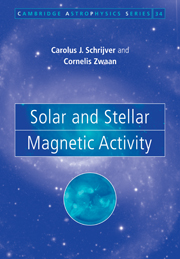Book contents
- Frontmatter
- Contents
- Preface
- 1 Introduction: solar features and terminology
- 2 Stellar structure
- 3 Solar differential rotation and meridional flow
- 4 Solar magnetic structure
- 5 Solar magnetic configurations
- 6 Global properties of the solar magnetic field
- 7 The solar dynamo
- 8 The solar outer atmosphere
- 9 Stellar outer atmospheres
- 10 Mechanisms of atmospheric heating
- 11 Activity and stellar properties
- 12 Stellar magnetic phenomena
- 13 Activity and rotation on evolutionary time scales
- 14 Activity in binary stars
- 15 Propositions on stellar dynamos
- Appendix I Unit conversions
- Bibliography
- Index
11 - Activity and stellar properties
Published online by Cambridge University Press: 14 August 2009
- Frontmatter
- Contents
- Preface
- 1 Introduction: solar features and terminology
- 2 Stellar structure
- 3 Solar differential rotation and meridional flow
- 4 Solar magnetic structure
- 5 Solar magnetic configurations
- 6 Global properties of the solar magnetic field
- 7 The solar dynamo
- 8 The solar outer atmosphere
- 9 Stellar outer atmospheres
- 10 Mechanisms of atmospheric heating
- 11 Activity and stellar properties
- 12 Stellar magnetic phenomena
- 13 Activity and rotation on evolutionary time scales
- 14 Activity in binary stars
- 15 Propositions on stellar dynamos
- Appendix I Unit conversions
- Bibliography
- Index
Summary
Activity throughout the H–R diagram
This section provides an overview of the magnetic activity of single stars across the H–R diagram; see Fig. 11.1. Activity in binary stars is discussed in Chapter 14. The observational data are summarized and qualitatively interpreted in terms of the empirical activity–rotation relation and the evolution of the rotation rate. The quantitative analysis follows in Section 11.3 and in Chapter 13.
Plots of Ca II H+K flux density against color (see Figs. 2.17 and 9.3) display a broad distribution of emission fluxes. Young stars from open clusters, such as the Pleiades and Hyades, occupy the upper strip in such plots, that is, above the Vaughan–Preston gap (Section 9.3.3). Older main-sequence stars, such as the Sun, and many subgiants and giants are found in the lower part of such plots.
Dedicated studies proved that a convective envelope is a necessary but not a sufficient condition for significant magnetic activity. A convective envelope turned out to be a necessary condition, because indications for magnetic activity are exclusively found in stars with convective envelopes (Fig. 11.1), which corresponds to the domain of the H–R diagram to the right of the granulation boundary (see Fig. 2.10), including pre-main-sequence stars, such as the T Tauri stars (these objects are discussed in Section 11.6).
A convective envelope is not a sufficient condition for significant magnetic activity, however: magnetic activity is found to depend on the stellar rotation rate (the activity– rotation relation is discussed in quantitative detail in Section 11.3).
- Type
- Chapter
- Information
- Solar and Stellar Magnetic Activity , pp. 277 - 302Publisher: Cambridge University PressPrint publication year: 2000



